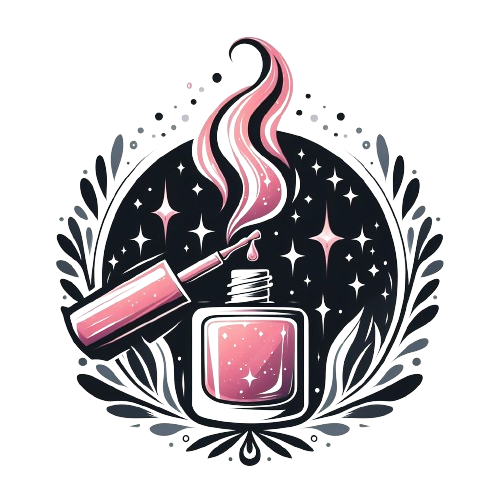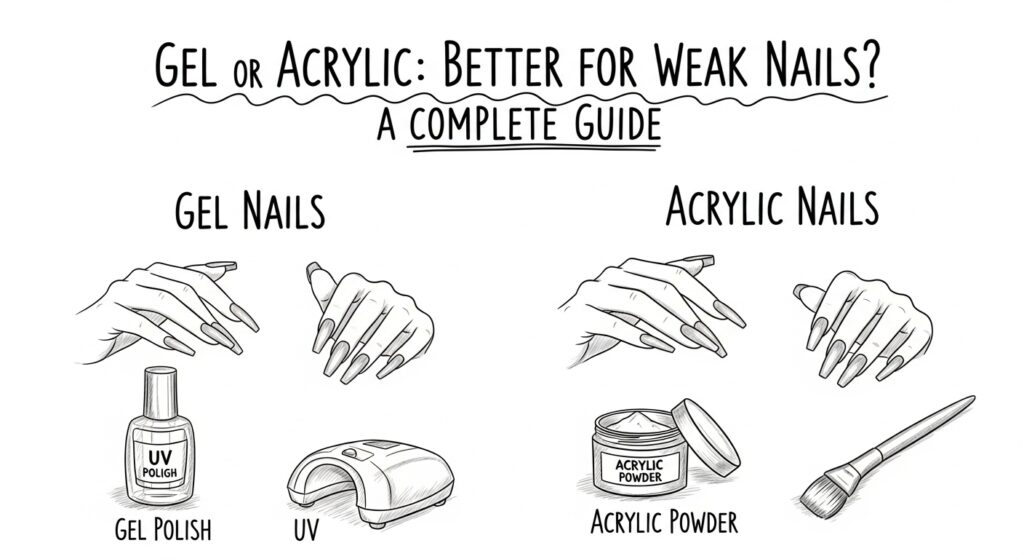If you’re dealing with weak, brittle nails and wondering is gel or acrylic better for weak nails, you’re not alone. Many people with fragile nails struggle to decide which enhancement will give them the beautiful, long-lasting manicure they want without causing further damage.
The truth is, both gel and acrylic have their advantages and disadvantages when it comes to weak nails, and the best choice depends on your specific nail condition, lifestyle, and maintenance preferences.
Understanding the fundamental differences between these two popular nail enhancements is crucial for making an informed decision that protects your natural nails while giving you the look you desir.
In this comprehensive guide, we’ll explore everything you need to know about gel and acrylic nails for weak nail beds, including their composition, application process, durability, and impact on nail health.
Understanding Weak Nails: What Causes Them?
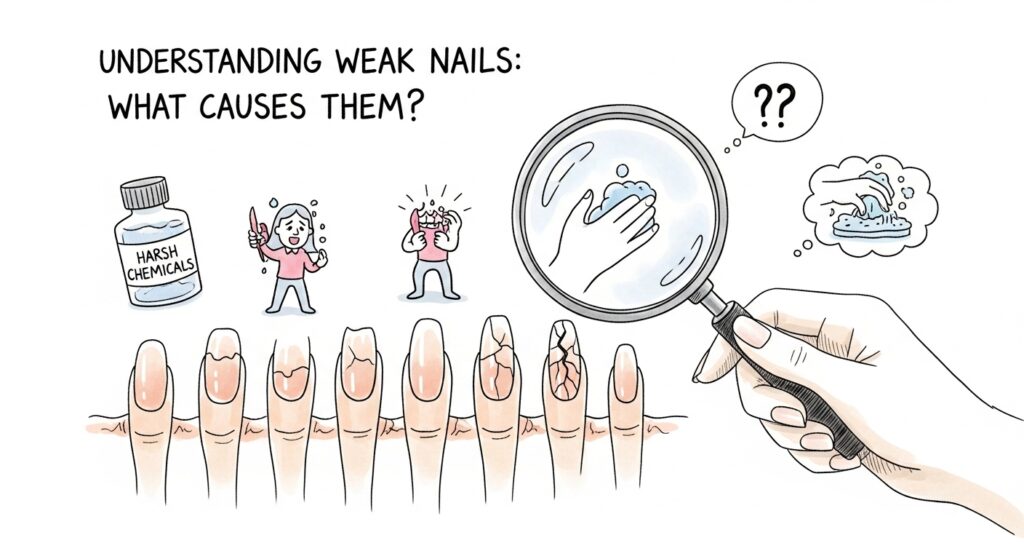
Before diving into whether gel or acrylic is better for weak nails, it’s important to understand what causes nail weakness in the first place. Weak nails can be brittle, thin, prone to peeling, or easily bendable. Common causes include:
- Nutritional deficiencies: Lack of biotin, protein, iron, or other essential vitamins
- Excessive exposure to water: Frequent hand washing or chemical exposure
- Harsh nail treatments: Over-filing, aggressive removal of previous enhancements
- Medical conditions: Thyroid issues, anemia, or fungal infections
- Aging: Natural changes in nail structure over time
- Dehydration: Both internal and external moisture loss
Understanding your nail weakness is the first step. If you’re unsure about your nail health and wellness, consulting with a dermatologist or experienced nail technician can provide valuable insights.
Implementing a proper nail care routine can also help strengthen your nails naturally over time.
What Are Gel Nails?
Gel nails are created using a gel-based polish that is cured under a UV or LED lamp. The gel comes in different forms:
- Soft gel: Traditional gel polish that sits on top of the natural nail
- Hard gel: A more durable formula that can be used for extensions
- Builder gel: A strengthening gel that adds thickness and support
The application process involves preparing the natural nail, applying a base coat, color coats, and a top coat, with each layer being cured under a lamp. To achieve the best results, you’ll need quality equipment, and checking out the best UV nail curing lamps can help ensure proper curing.
Advantages of Gel for Weak Nails
Natural Look and Flexibility: Gel nails maintain a more natural appearance and flexibility compared to acrylics. This flexibility can be beneficial for weak nails because it moves with your natural nail, reducing the risk of cracking or breakage.
Less Harsh Application: The gel application process doesn’t require harsh primers or strong-smelling monomers. There’s minimal filing of the natural nail surface, which preserves more of your natural nail structure.
Easier Removal: When removed properly using the soak-off method, gel polish causes less damage than acrylic. However, many people wonder why does my gel nail polish peel off, which is often due to improper application or preparation.
Strengthening Properties: Builder gel specifically can add a protective layer that helps prevent weak nails from breaking while allowing them to grow underneath. Many people ask will gel polish strengthen nails, and the answer depends on the type of gel used and proper application.
Disadvantages of Gel for Weak Nails
Less Durability: Gel nails may not last as long as acrylics, especially if you use your hands frequently for work or household tasks.
Limited Repair Options: If a gel nail chips or breaks, it usually requires a complete removal and reapplication.
UV Exposure: The curing process requires UV light exposure, though LED lamps minimize this. It’s important to avoid common UV lamp mistakes that could damage your nails or skin.
Stickiness Issues: After curing, you might notice residue. If you’ve experienced this, learn more about why is my gel nail so sticky to understand the inhibition layer.
What Are Acrylic Nails?
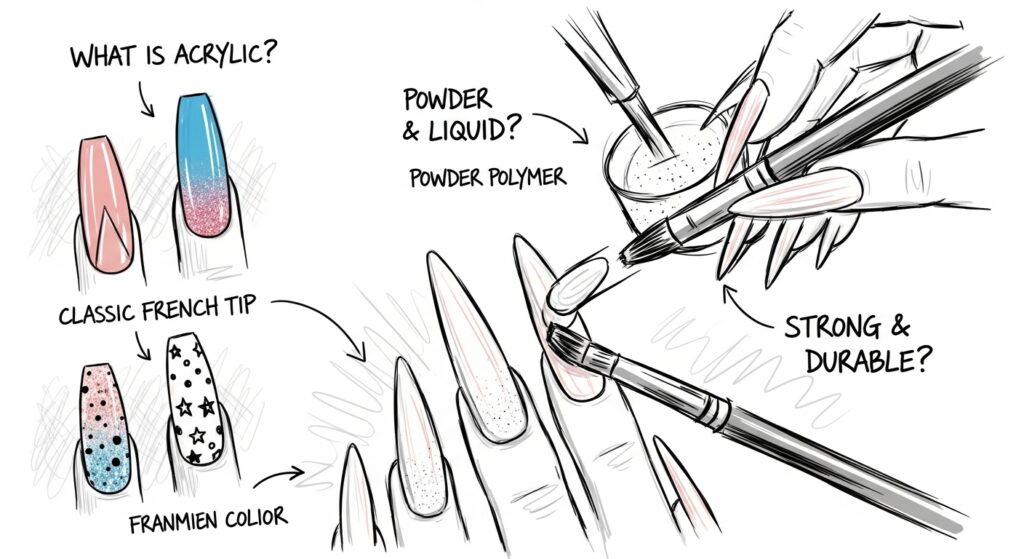
Acrylic nails are created by combining a liquid monomer with a powder polymer to form a paste that hardens when exposed to air.
This creates a strong, durable artificial nail that can be shaped and filed. For those new to acrylics, understanding what are acrylic nail extensions provides a solid foundation.
The application process involves:
- Preparing and priming the natural nail
- Applying nail tips or forms (if adding length)
- Brushing on the acrylic mixture
- Shaping and filing once hardened
- Buffing and polishing or adding gel polish
Advantages of Acrylic for Weak Nails
Maximum Protection: Acrylic creates a hard, protective shell over weak nails, preventing them from bending, breaking, or peeling. This rigid barrier allows your natural nails to grow underneath without exposure to daily wear and tear.
Superior Durability: Acrylic nails typically last 3-4 weeks and can withstand more impact and pressure than gel nails, making them ideal if you’re tough on your hands.
Easy Repairs: If an acrylic nail chips or breaks, it can often be repaired by a technician without requiring complete removal and reapplication.
Immediate Length: For those with severely weak or short nails, acrylics can provide instant length and shape that would take months to achieve naturally.
Cost-Effective: Generally, acrylic application is less expensive than gel, and because repairs are possible, maintenance costs may be lower over time.
Disadvantages of Acrylic for Weak Nails
Harsh Application Process: The application requires filing down the natural nail surface to create adhesion, which temporarily weakens the nail further. Primers used can also be drying.
Strong Odor: The monomer liquid has a strong chemical smell that can be unpleasant and may cause sensitivity in some people.
Less Natural Appearance: Acrylic nails tend to look thicker and less natural than gel nails, especially if not applied by a skilled technician.
Difficult Removal: Removing acrylic nails requires significant soaking in acetone, which is extremely drying. Learning how to get acrylic nails off properly is crucial to minimize damage.
Maintenance Requirements: Acrylic nails require regular fills every 2-3 weeks as your natural nail grows, creating a visible gap at the cuticle.
Gel vs Acrylic: Direct Comparison for Weak Nails
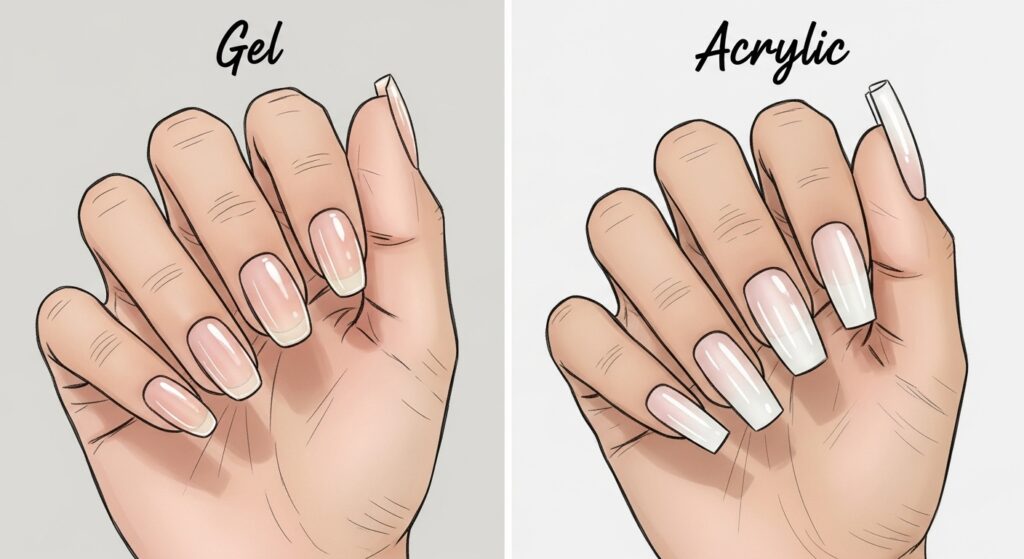
Durability and Strength
Winner: Acrylic Acrylic provides superior strength and protection for weak nails. The hard shell prevents bending and breaking, offering maximum support.
Natural Appearance
Winner: Gel Gel nails look more natural, feel lighter, and have a glossier finish straight from the lamp.
Flexibility
Winner: Gel Gel moves with your natural nail, which can prevent cracking. However, this flexibility means less rigid protection.
Application Damage
Winner: Gel Gel requires less filing of the natural nail and uses gentler products, causing less immediate damage to already weak nails.
Removal Impact
Winner: Gel Properly removed gel polish causes less damage than acrylic removal, though both require care.
Longevity
Winner: Acrylic Acrylic lasts longer between appointments and better resists chipping and daily wear.
For a more detailed comparison, check out this comprehensive guide on gel vs dip nails, which also discusses alternative options.
Is Gel or Acrylic Better for Weak Nails? The Verdict
The answer depends on your priorities and the severity of your nail weakness:
Choose Gel If:
- Your nails are slightly weak but not severely damaged
- You prioritize a natural look and feel
- You’re concerned about harsh chemicals
- You can be gentle with your hands
- You want flexibility that moves with your natural nail
- You’re committed to proper removal techniques
Choose Acrylic If:
- Your nails are extremely weak, thin, or brittle
- You need maximum protection and durability
- You use your hands frequently for work or activities
- You want the longest-lasting option
- You’re looking for significant length
- You don’t mind more frequent maintenance appointments
Important Note: Neither option will “heal” weak nails. Both simply provide protection while your natural nails grow. The key is focusing on nail health during and after wearing enhancements.
Best Practices for Weak Nails with Enhancements
Regardless of whether you choose gel or acrylic, follow these guidelines to protect your weak nails:
During Application
- Choose an experienced, licensed nail technician
- Ensure proper sanitation of all tools
- Don’t allow excessive filing of your natural nail
- Speak up if you feel burning or discomfort
- Consider shorter lengths to reduce stress on weak nails
During Wear
- Keep your hands and cuticles moisturized with oils like jojoba oil for cuticles care
- Wear gloves when doing housework or using chemicals
- Avoid using your nails as tools
- Apply cuticle oil daily, learning about what is cuticle cream and its benefits
- Don’t pick at lifted edges; see your technician for repairs
During Removal
- Never peel or pick off enhancements
- Soak properly in acetone (for gel) or have professional removal
- Allow nails to rest between applications
- Apply strengthening treatments during breaks
After Removal
If you want to restore your nail health, learn how to strengthen nails after gel treatments. This includes using nail strengtheners, biotin supplements, and giving your nails time to recover.
Alternative Options for Weak Nails
If you’re concerned about the potential damage from gel or acrylic, consider these alternatives:
Dip Powder Nails
Dip powder provides strength similar to acrylic but with a simpler application process. It lasts 3-4 weeks and doesn’t require UV curing.
Press-On Nails
Modern press-on nails have improved significantly and can look natural. They’re a great temporary option that causes no damage. Learn how to make press-on nails last for the best results.
Semi-Cured Gel Strips
These provide a middle ground with gel-like shine and wear without the need for UV curing. When you’re ready to remove them, check out how to remove semi-cured gel nail strips.
Builder Gel in a Bottle (BIAB)
This newer option strengthens natural nails while allowing them to breathe. Many wonder is builder nail gel bad for your nails, and research shows it can be one of the gentler enhancement options.
Natural Nail Strengthening
Sometimes the best option is to skip enhancements altogether and focus on naturally strengthening your nails through proper nail care routine, diet, and protective measures.
Product Recommendations for Weak Nails
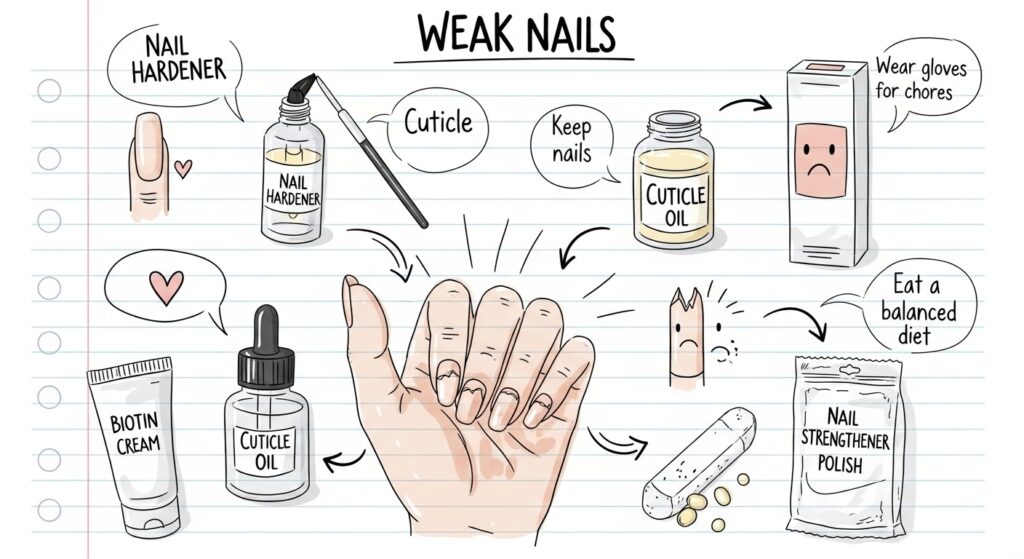
For Gel Nail Enthusiasts
Best Gel Starter Kit: Beetles Gel Nail Polish Kit This complete kit includes everything you need: LED lamp, base and top coat, color polishes, and removal tools.
The LED lamp cures quickly and evenly, reducing the risk of under-curing that can lead to peeling. Perfect for beginners, and you can find more options in our guide to best gel nail starter kits.
Best Builder Gel: The GelBottle Inc. BIAB Specifically designed for nail strengthening, this builder gel adds thickness without excessive rigidity. It’s flexible enough to move with weak nails while providing protection.
Best UV Lamp: MelodySusie 84W UV LED Nail Lamp With powerful curing capability and auto-sensor technology, this lamp ensures complete curing, which is essential for preventing lifting and damage to weak nails.
For Acrylic Nail Users
Best Acrylic System: Mia Secret Professional Acrylic Kit This professional-grade kit includes everything needed for safe acrylic application. The monomer is formulated to be less odorous while maintaining strength.
Best Nail Prep: Young Nails Protein Bond This protein-based primer creates excellent adhesion without the harsh acids found in traditional primers, making it gentler on weak nails.
Best Acrylic Brush: Kolinsky Sable Brush Size 8 A quality brush is essential for smooth, even application that minimizes the need for excessive filing. Learn about best acrylic brush cleaners to maintain your tools.
For Post-Enhancement Care
Best Cuticle Oil: CND Solar Oil Packed with jojoba oil and vitamin E, this cuticle oil penetrates deeply to keep nails and cuticles hydrated during and after wearing enhancements.
Best Nail Strengthener: OPI Nail Envy This treatment helps restore weak nails after enhancement removal. Use it during breaks between applications to rebuild strength.
Best Nail File: Glass Nail File Gentler than traditional emery boards, glass files seal the nail edge to prevent splitting and peeling, which is crucial for weak nails.
Common Mistakes to Avoid
For Both Gel and Acrylic
- Skipping Prep Steps: Proper nail preparation is crucial for adhesion and preventing lifting that can damage weak nails.
- Going Too Long: Extended length puts stress on weak nails. Start with shorter enhancements and gradually increase if desired.
- Ignoring Signs of Damage: If you notice pain, greenness (fungal infection), or severe thinning, remove enhancements immediately.
- Not Taking Breaks: Continuous wear without breaks prevents your natural nails from recovering and can lead to long-term weakness.
- DIY Removal: Improper removal causes more damage than the enhancements themselves. Always remove them correctly or see a professional.
- Neglecting Nail Health: Enhancements are a bandage, not a cure. Address underlying causes of nail weakness through nutrition, hydration, and proper care.
When to See a Professional
Consult a dermatologist or healthcare provider if you experience:
- Persistent nail weakness despite proper care
- Discoloration, especially green or black spots
- Pain or tenderness around the nail
- Unusual nail texture or thickness changes
- Signs of infection
- Nail separation from the nail bed
For some individuals, nail weakness may indicate underlying health issues such as thyroid problems, fungal infections (learn about will UV light kill nail fungus), or nutritional deficiencies that require medical attention.
Tips for Maintaining Healthy Nails with Enhancements

- Stay Hydrated: Drink plenty of water and use cuticle oil daily to maintain moisture in the nail bed.
- Take Biotin Supplements: Studies suggest biotin can improve nail strength over time when taken consistently.
- Protect Your Investment: Wear gloves during household chores and avoid prolonged water exposure.
- Schedule Regular Maintenance: Don’t let fills or growth go too long, as this increases stress on weak nails.
- Keep Nails Clean: Use proper nail hygiene, including knowing how to clean nail clippers and other tools to prevent infections.
- Learn Proper Techniques: If doing at-home manicures, master how to do a French manicure at home and how to treat cuticles properly.
- Address Emergencies: Know how to fix a broken nail at home to prevent further damage.
Additional Considerations
Seasonal Factors
Nail health can vary by season. Cold, dry winter months may make weak nails more brittle, while summer humidity might help.
Consider exploring March nail designs or light purple nails design for seasonal inspiration that works with your nail enhancement choice.
Color and Staining
If you’re concerned about nail discoloration from polish or treatments, learn how to remove yellow stains from nails and understand why are my nails see through to identify potential issues.
Safety Concerns
For those worried about chemical exposure, research shows that most nail products are safe when used correctly.
However, if you’re particularly sensitive, you might wonder do nail polish stickers have formaldehyde or does nail varnish damage nails.
Final Thoughts
So, is gel or acrylic better for weak nails? For most people with weak nails, acrylic provides superior protection and allows nails to grow safely underneath, while gel offers a gentler, more natural option for those with moderately weak nails who can be careful with their hands.
The best approach is often a hybrid strategy: use acrylic for maximum protection during the initial strengthening phase, then transition to gel or builder gel as your natural nails become stronger. Some people alternate between both, giving their nails breaks with strengthening treatments in between.
Remember that enhancements are temporary solutions. True nail health comes from addressing underlying causes, maintaining proper nutrition, using quality products, and following good nail care practices.
Whether you choose gel or acrylic, prioritize the health of your natural nails by using experienced technicians, following proper application and removal protocols, and giving your nails regular breaks to recover.
Consult with a trusted nail technician who can assess your specific nail condition and recommend the best option for your lifestyle and goals. With the right choice and proper care, you can enjoy beautiful nails while protecting and strengthening your natural nail bed.
Sources
- American Academy of Dermatology. “Tips for Healthy Nails.” https://www.aad.org/public/everyday-care/nail-care-secrets/basics/healthy-nail-tips
- British Journal of Dermatology. “Nail Cosmetics in Nail Disorders.”
- Journal of Clinical and Aesthetic Dermatology. “Biotin and Nail Health.”
- International Nail Technicians Association. “Best Practices for Nail Enhancements.”
- FDA. “Nail Care Products: Safety Information.” https://www.fda.gov/cosmetics/cosmetic-products/nail-care-products
